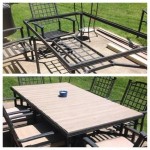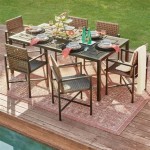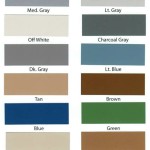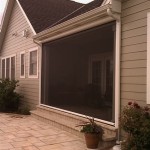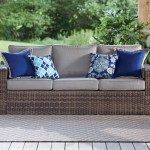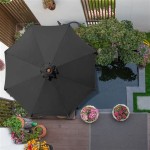Covers For Sectional Patio Furniture: Protection and Longevity
Sectional patio furniture represents a significant investment for many homeowners. These versatile outdoor seating arrangements provide comfort and style, transforming patios and decks into inviting spaces for relaxation and entertainment. However, prolonged exposure to the elements can degrade the materials, diminish aesthetic appeal, and ultimately shorten the lifespan of the furniture. Patio furniture covers provide a crucial layer of protection against weather damage, extending the life of your investment and maintaining its appearance.
Choosing the right cover for sectional patio furniture involves careful consideration of factors such as material, size, features, and environmental conditions. Selection should also include a consideration of price point. Selecting the appropriate cover ensures optimal protection and satisfaction.
Understanding the Importance of Patio Furniture Covers
The primary function of patio furniture covers is to shield furniture from the damaging effects of weather. This protection encompasses a range of environmental factors, each contributing to the gradual deterioration of outdoor furnishings. The following details the significant issues that can be mitigated with the correct use of protective furniture covers.
Sunlight: Prolonged exposure to ultraviolet (UV) rays causes fading, discoloration, and weakening of fabrics and plastics. Covers act as a barrier, preventing UV radiation from directly contacting the furniture surface. Darker colors are particularly susceptible to fading and degradation under intense sunlight. Covers effectively block the sun, preserving the original color and integrity of the furniture material.
Rain and Moisture: Rainwater can seep into cushions, causing mold and mildew growth. This not only creates unsightly stains and unpleasant odors but also poses a health risk. Moisture can also lead to rusting of metal frames and rotting of wooden components. Waterproof covers prevent water from penetrating the furniture, keeping it dry and protected from moisture-related damage. However, ventilation is also vital, as trapped moisture can also lead to issues, thus, it is key to choose a cover that does not fully seal the furniture.
Wind: Strong winds can blow debris such as leaves, dust, and pollen onto patio furniture. This dirt accumulation requires frequent cleaning and can scratch or stain surfaces. Furthermore, unsecured lightweight furniture can be blown around, potentially causing damage to the furniture itself or surrounding structures. Covers, especially those with secure fastening systems, prevent debris accumulation and keep furniture in place during windy conditions.
Snow and Ice: In colder climates, snow and ice accumulation can place significant stress on furniture frames and cushions. The repeated freeze-thaw cycle can cause materials to crack and warp. Heavy snow loads can damage supports and joints. Durable, waterproof covers protect furniture from snow and ice, preventing moisture penetration and structural damage. Covers with reinforced seams and high weight capacity are suitable for areas with heavy snowfall.
Animals and Pests: Patio furniture can become a target for animals and pests. Birds may leave droppings, squirrels may nest in cushions, and insects may infest wooden frames. Covers prevent animals from accessing the furniture, reducing the need for frequent cleaning and pest control measures. Tightly woven, durable covers are resistant to tearing and penetration by animals.
Key Features to Consider When Selecting Patio Furniture Covers
Choosing the right cover for sectional patio furniture requires evaluating various features to ensure effective protection and user satisfaction. These features determine the cover's durability, weather resistance, ease of use, and overall performance. Here are some of the key aspects to consider:
Material: The material of the cover is the most critical factor. Common materials include polyester, vinyl, and polyethylene. Polyester covers are lightweight, water-resistant, and relatively inexpensive. They offer adequate protection against sun, rain, and wind. Vinyl covers are more durable and waterproof than polyester, providing superior protection against moisture. However, they can be less breathable and may become brittle in cold weather. Polyethylene covers are heavy-duty and offer excellent protection against all weather conditions. They are often used for long-term storage or in harsh climates. Material selection should balance cost, durability, and breathability.
Water Resistance and Waterproofing: In wet climates, a water-resistant or waterproof cover is essential. Water-resistant covers repel water to some degree, while waterproof covers prevent water from penetrating the fabric. Look for covers with sealed seams to prevent water from seeping through stitching. Breathability is also important to prevent moisture buildup inside the cover, which can lead to mold and mildew growth. Some covers feature vents or breathable fabrics to promote air circulation.
UV Protection: The cover should offer adequate UV protection to prevent fading and degradation of furniture materials. Covers made from UV-resistant fabrics or treated with UV inhibitors provide superior protection against sunlight. Darker colored covers generally offer better UV protection than lighter colored covers. Check the product specifications for UV protection ratings or claims.
Size and Fit: Accurate measurements of the sectional patio furniture are crucial for selecting the right size cover. The cover should fit snugly but not too tightly, allowing for easy installation and removal. Oversized covers can trap wind and debris, while undersized covers may not provide adequate protection. Many manufacturers offer covers specifically designed for sectional patio furniture with various configurations. Consider the shape and dimensions of the sectional when choosing a cover.
Fastening Systems: Secure fastening systems are essential to keep the cover in place during windy conditions. Common fastening systems include straps, buckles, drawstrings, and elastic hems. Straps and buckles provide a secure and adjustable fit, while drawstrings allow for tightening the cover around the furniture. Elastic hems offer a snug fit and are easy to use. Choose a fastening system that is durable, easy to operate, and compatible with the furniture design.
Ventilation: Adequate ventilation is important to prevent moisture buildup inside the cover, which can lead to mold and mildew growth. Vents or breathable fabrics allow air to circulate, reducing condensation and promoting drying. Position vents strategically to maximize airflow while minimizing water penetration.
Durability and Construction: The cover should be made from durable materials and constructed with reinforced seams to withstand wear and tear. Look for covers with double-stitched or taped seams for added strength. Check the fabric weight and thickness to assess its resistance to tearing and abrasion. Heavy-duty covers are more durable and provide better protection than lightweight covers.
Ease of Use: The cover should be easy to install and remove. Features such as handles, zippers, and lightweight materials can simplify the process. Consider the storage requirements for the cover when not in use. Some covers come with storage bags or can be folded compactly for easy storage.
Maintenance and Care of Your Patio Furniture Covers
Proper maintenance and care of patio furniture covers are essential to prolong their lifespan and ensure optimal protection. Regular cleaning and storage practices can prevent damage and maintain the cover's performance. The following outlines the best methods for maintaining the covers.
Regular Cleaning: Clean the cover regularly to remove dirt, debris, and stains. Use a soft brush or cloth and mild soap to clean the surface. Avoid using harsh chemicals or abrasive cleaners, as they can damage the fabric. Rinse the cover thoroughly with water and allow it to air dry completely before storing. Cleaning frequency depends on the environmental conditions and the level of dirt accumulation.
Spot Cleaning: Address stains and spills promptly to prevent them from setting into the fabric. Use a spot cleaner or a mixture of mild soap and water to gently blot the affected area. Avoid rubbing the stain, as this can spread it or damage the fabric. Rinse the area with water and allow it to air dry. For stubborn stains, consider using a specialized stain remover designed for outdoor fabrics.
Mold and Mildew Prevention: Mold and mildew can grow on patio furniture covers, especially in humid climates. To prevent mold and mildew growth, ensure adequate ventilation and avoid storing the cover when it is wet. Clean the cover regularly with a mold and mildew cleaner, following the manufacturer's instructions. Consider using a fabric protectant with antimicrobial properties to inhibit mold and mildew growth.
Proper Storage: Store the cover in a clean, dry place when not in use. Avoid storing the cover in direct sunlight or extreme temperatures, as this can damage the fabric. Fold the cover neatly and store it in a storage bag or container to protect it from dust and pests. Ensure that the cover is completely dry before storing to prevent mold and mildew growth.
Repairing Tears and Damages: Inspect the cover regularly for tears, holes, or other damages. Repair minor tears with a fabric patch or sewing kit. For larger damages, consider taking the cover to a professional repair shop. Promptly repairing damages can prevent further deterioration and extend the lifespan of the cover.
Replacing the Cover: Even with proper maintenance, patio furniture covers eventually wear out and need to be replaced. Factors such as UV exposure, weather conditions, and usage frequency can affect the lifespan of the cover. Inspect the cover regularly for signs of wear and tear, such as fading, cracking, or loss of water resistance. Replace the cover when it no longer provides adequate protection or when it is damaged beyond repair. Selecting a new cover with improved features or materials can enhance the protection and longevity of your patio furniture.
Selecting and maintaining the correct cover for sectional patio furniture requires a thorough understanding of materials, environmental factors, and proper care. By investing in a quality cover and following these guidelines, homeowners can preserve the beauty and extend the lifespan of their outdoor furniture.

Outdoor Sectional Sofa Cover Square Waterproof 98 X Dolapatio

Startwo Outdoor V Shaped Sectional Cover Waterproof Patio Furniture Covers Garden Couch For Sofa Walmart Com

Startwo Heavy Duty Patio Furniture Cover For 7 9 Piece Outdoor Sectional Sofa Set Waterproof And Durable

Gasadar Waterproof Heavy Duty 126 In L X W 28 H Gray Patio Furniture Cover Hd Jx034 1 The Home

Gabrielle Waterproof Garden Corner Sofa Cover Protective For L Shaped Furniture Patio

Pvc Patio Furniture Covers At Lowes Com

Outsunny 97 X 65 26 Weatherproof Outdoor Sectional Patio Furniture Cover With Ultimate Protection Beige Sofa Chaise Chair Protector X65 X26 Aosom

Ylln 12 Piece Patio Cushion Covers Replacement With Zipper Waterproof Sectional Sofa Set For Outdoor Cushions Dark Grey 12pc Sh Ydt The Home
Outdoor Patio Furniture Cover Sectional Group Costco

Iria Protective Cover For 7 Seater Outdoor Corner Sofa Max 330 X Kave Home
See Also

